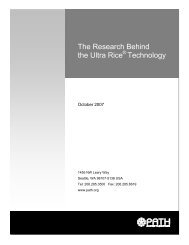Nepal Clean Home Delivery Kit: Evaluation of the Health Impact - Path
Nepal Clean Home Delivery Kit: Evaluation of the Health Impact - Path
Nepal Clean Home Delivery Kit: Evaluation of the Health Impact - Path
Create successful ePaper yourself
Turn your PDF publications into a flip-book with our unique Google optimized e-Paper software.
asked about use <strong>of</strong> <strong>the</strong> kit contents; disposal or reuse <strong>of</strong> <strong>the</strong> kit contents after <strong>the</strong> delivery;<br />
and understanding <strong>of</strong> <strong>the</strong> key messages in <strong>the</strong> kit insert. All mo<strong>the</strong>rs were asked about<br />
factors that might be related to <strong>the</strong> actual use <strong>of</strong> kits, <strong>the</strong>ir effectiveness or <strong>the</strong> analysis <strong>of</strong><br />
<strong>the</strong> kit’s impact, such as sociodemographic factors, health history factors, and events<br />
associated with <strong>the</strong> delivery. Mo<strong>the</strong>rs were asked about acceptability <strong>of</strong> kits and access to<br />
kits, such as preferred outlets for obtaining delivery kits.<br />
Since <strong>the</strong> mo<strong>the</strong>r might not be aware <strong>of</strong> all <strong>the</strong> details <strong>of</strong> what happened during <strong>the</strong><br />
delivery, o<strong>the</strong>r women in <strong>the</strong> household who were present at <strong>the</strong> delivery were asked to<br />
provide information as needed. The information recorded on <strong>the</strong> primary data collection<br />
form represents a consensus <strong>of</strong> household opinion or recollection. A slightly altered<br />
version <strong>of</strong> <strong>the</strong> standard questionnaire was used in <strong>the</strong> case <strong>of</strong> a neonatal death, with some<br />
change in wording to take account <strong>of</strong> <strong>the</strong> newborn’s death and some additional questions<br />
to determine whe<strong>the</strong>r <strong>the</strong> cause <strong>of</strong> death was related to newborn cord infection.<br />
A supplementary interview form was used to ga<strong>the</strong>r information from a subset <strong>of</strong> trained<br />
birth attendants to validate mo<strong>the</strong>rs’ reports on birth attendant practices. This follow-up<br />
interview was conducted as soon as possible after <strong>the</strong> mo<strong>the</strong>r’s interview and covered<br />
aspects <strong>of</strong> <strong>the</strong> behavior <strong>of</strong> <strong>the</strong> birth attendant during delivery with regard to hand washing<br />
and wrapping <strong>the</strong> baby, mo<strong>the</strong>r’s initiation <strong>of</strong> breastfeeding within an hour <strong>of</strong> birth, use <strong>of</strong><br />
<strong>the</strong> kit contents, disposal or reuse <strong>of</strong> <strong>the</strong> kit contents after <strong>the</strong> delivery, and understanding<br />
<strong>of</strong> <strong>the</strong> instructions and key messages in <strong>the</strong> kit insert. The data provided by <strong>the</strong> TBA was<br />
compared with reports provided by <strong>the</strong> mo<strong>the</strong>r and her household members who observed<br />
<strong>the</strong> delivery.<br />
Data collection instruments were translated into <strong>the</strong> required local languages,<br />
back-translated, and pretested before use. A field manual (translated into <strong>Nepal</strong>i) was<br />
prepared as a reference for <strong>the</strong> field workers. The six field interviewers received one<br />
week <strong>of</strong> training, including role playing <strong>the</strong> interviews. The Field Director reviewed all<br />
interview forms for accuracy and completeness and observed each field interviewer<br />
periodically throughout <strong>the</strong> study, to ensure quality and uniformity <strong>of</strong> data collection. An<br />
assistant coded open-ended questions.<br />
Determination <strong>of</strong> infection status. Color photos <strong>of</strong> normal and infected cord stumps were<br />
shown to respondents to help <strong>the</strong>m determine whe<strong>the</strong>r or not <strong>the</strong> newborn had an episode<br />
<strong>of</strong> cord infection. In addition, <strong>the</strong> interviewer inspected <strong>the</strong> baby’s cord and/or abdomen<br />
to ascertain its status at <strong>the</strong> time <strong>of</strong> <strong>the</strong> interview, whenever possible. A neonatologist<br />
reviewed all records with any indication <strong>of</strong> possible infection—including mo<strong>the</strong>r’s report<br />
<strong>of</strong> symptoms and appearance and interviewer’s observations—and made <strong>the</strong> final<br />
determination as to whe<strong>the</strong>r a cord-related infection was involved (rating it as “definite”,<br />
“probable”, “possible”, or “unlikely”).<br />
Data Analysis<br />
The interview form was precoded for computer entry. Data were entered into an Epi Info<br />
6.0 data entry program (with appropriate checks built into it) by a bilingual statistician in<br />
7<br />
<strong>Nepal</strong> <strong>Delivery</strong> <strong>Kit</strong> <strong>Evaluation</strong> May 2000
















